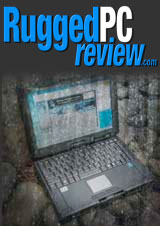RuggON announced the RuggVMC VIKING (MT7030) in late March 2020 as a durable, powerful all-in-one vehicle terminal for fleet management, asset management, and Electronic Logging (ELD) applications. The MT7000 Series was initially created as a modern, fanless vehicle PC implementation designed to leverage existing and emerging IoT applications. The VIKING is a significant technology update and refresh to the original MT7000 platform.
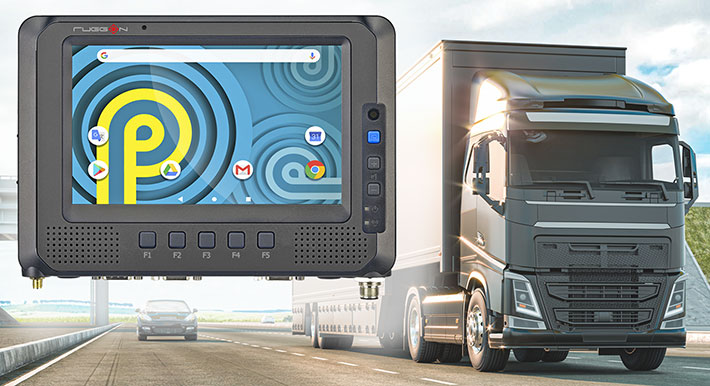
Measuring a compact 8.7 x 6.0 x 1.61 inches, the VIKING all-in-one in-vehicle terminal provides a comprehensive, easy-to-use touch/pushbutton hybrid interface to all sorts of dispatch systems, asset and fleet management applications, diagnostic monitoring systems, as well as vehicle navigation and tracking metrics.
Equipped with WiFi, mobile broadband, and dedicated GNSS plus antennae, the VIKING is completely connected both in-vehicle and as part of IoT/cloud wide area applications. This enables a vast range of productivity enhancement and value-added functionality.
But what, exactly, is the RuggON VIKING? Most computers that are built for use on tough jobs come as handhelds, tablets, laptops and panels. The VIKING is none of those. Instead, it's a more specialized version of rugged computer — a vehicle computer. Not the type of vehicle computer that's called "ECU" (Electronic Control Units) and handles all of modern cars' and trucks' internal systems, but a vehicle computer designed to be used in trucks and all sorts of other mobile settings, such as forklifts, construction machinery, airports and so on. It is a durable, powerful, all-in-one vehicle terminal for tasks like fleet management, asset management, and Electronic Logging (ELD) applications.
RuggON VIKING: design and concept
The VIKING is small. Its 8.7 x 6.0 inch footprint is small, much smaller than an iPad and more like the type of screen built into the dash of most modern cars. That's so that the computer can be installed in just about any vehicle, and doesn't get in the way. But it is big enough to function as an all-in-one in-vehicle terminal with an easy-to-use hardware/software interface.
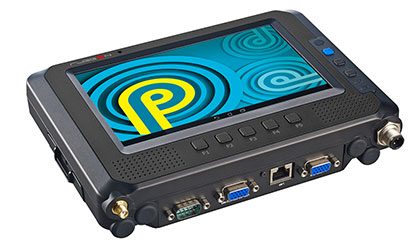 As the image to the right shows, unlike in-dash systems that usually have no external I/O at all, the VIKING has plenty. It can be wired into all sorts of vehicle systems, external communication systems, as well as onboard accessories and peripherals.
As the image to the right shows, unlike in-dash systems that usually have no external I/O at all, the VIKING has plenty. It can be wired into all sorts of vehicle systems, external communication systems, as well as onboard accessories and peripherals.
In the past, any such system would have run Microsoft Windows so as to seamlessly tie into enterprise and backoffice IT infrastructures, and to leverage the universal availability of Windows software and programming resources. Windows, of course, remains the cornerstone of corporate IT and desktop and laptop users the world over. But smaller systems increasingly benefit from the simplicity of Android, an OS platform designed for touch from the start, and familiar to literally billions of users.
Like almost all computers designed as vehicle-mounts, the VIKING runs on vehicle power and can handle a wide range of available voltages, 9 to 36 Volt in this case. It has smart power management with ignition sense and also a small internal backup battery to handle onboard power fluctuations or to move the unit to another vehicle.
Below is a look at the RuggON VIKING from the front and from all four sides:
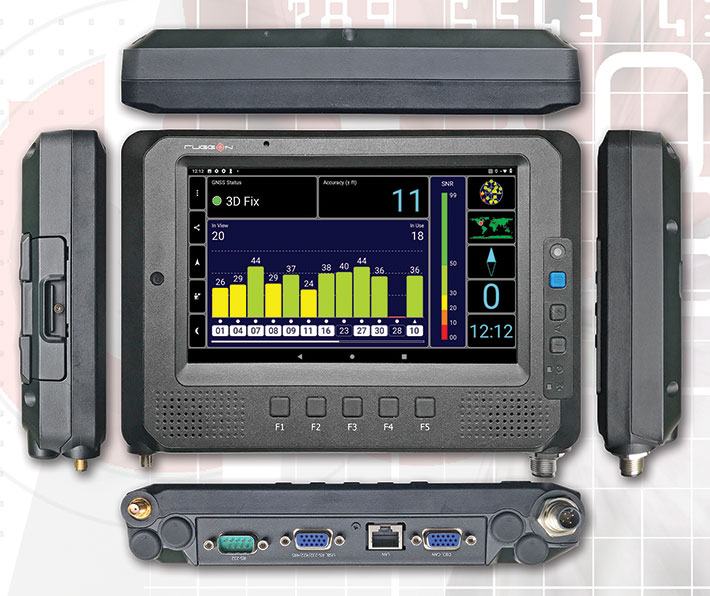
While most Android devices only have the three standard Android buttons, usually implemented as touch areas in software, the VIKING has those but also five programmable physical function buttons. That a big plus. While driving or otherwise operating a vehicle, having physical buttons available can be quicker and safer than onscreen buttons or menus.
On the left side is, for user convenience, a USB Type A 3.0 port, a standard 3.5 mm audio jack, as well as slots for a Micro SD card and a Micro SIM card. Stereo speakers are front-facing for optimized sound, and the VIKING also has a user-facing camera for video conversations.
A big plus here is a USB 3.1 Type C port on the backside of the device. Type C is the newer, smaller-size reversible plug where cables plug in either way. And this one also supports DisplayPort to plug in and drive a second screen.
As is common practice in vehicle-mounts, most of the VIKING's I/O is facing downward for easy out-of-the-way wire connections in the vehicle. Unlike Android-based smartphones and consumer tablets that usually have just a single small port or two, the VIKING has substantial onboard wired connectivity. The device can talk not only via USB and legacy serial communication protocols, but also via raw CAN bus, digital I/O and, optionally, SAE J1939.

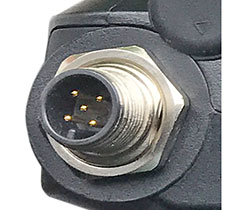 The close-up image above shows the primary I/O area of the VIKING. There are no protective port covers like you find on most rugged tablets. That's because the I/O block is a separate module that plugs into a sealed connector on the housing. This means dust and liquids cannot get inside the unit through these ports.
The close-up image above shows the primary I/O area of the VIKING. There are no protective port covers like you find on most rugged tablets. That's because the I/O block is a separate module that plugs into a sealed connector on the housing. This means dust and liquids cannot get inside the unit through these ports.
The RuggON VIKING provides the following onboard I/O, from left to right:
- Industrial screw-on power connector for 12 to 36 VDC
- 1 x Digital IO and CANBus (2 x digital in, 2 x digital out)
- 1 x RJ45 Gigabit LAN jack
- 1 x combination RS232/422/485 serial and USB
- 1 x RS232 serial with power
- 1 x GNSS external antenna port
The picture above right shows the screw-on power jack of the VIKING. Note the notch inside where the pins are. This ascertains that the power plug is inserted the right way. That can be a little tricky, so make sure everything is aligned properly.
Android VIKING vs Windows MT7000
When there are two computers that look the same but are different inside and use a different operating system, how do you compare them? How do you decide which one is better, or better suited for your application? And on the manufacturers' side, which platform should you support, and how should you go about it?
There are no simple answers. Microsoft has completely dominated the desktop and laptop market for almost four decades now. Microsoft also dominates IT, and there is an incredible wealth of software that runs on Windows, including most of the truly complex systems. Android, on the other hand, dominates the massive smartphone market and there's a huge number of Android apps.
|
RuggON RuggVMC
|
VIKING
|
MT7000
|
|
Introduced
|
2020
|
2017
|
|
Display
|
7-inch 1024x600
|
7-inch 1024x600
|
|
Luminance
|
500 nits
|
500 nits
|
|
Touch
|
Capacitive multi
|
Capacitive multi
|
|
OS
|
Android 9.0 GMS
|
Windows 10
|
|
CPU
|
Qualcomm SD660
|
Intel Atom E3815
|
|
Size (inches)
|
8.7 x 6.0 x 1.61
|
8.7 x 6.0 x 1.57
|
|
Weight (lbs.)
|
2.75
|
2.75
|
|
RAM
|
3GB LPDDR4
|
2GB DDR3L
|
|
Storage
|
32GB eMMC
|
mSATA
|
|
USB
|
1 x 2.0, 1 x 3.0
|
1 x 2.0, 1 x 3.0
|
|
USB Type C
|
1
|
NA
|
|
RJ45 LAN
|
1
|
1
|
|
Digital I/O
|
DI x 2, DO x 2
|
DI x 2, DO x 2
|
|
RS232 w/power
|
1
|
1
|
|
RS232/422/485
|
1
|
1
|
|
CAN bus
|
yes (raw)
|
yes
|
|
J1939 support
|
optional
|
yes
|
|
WiFi
|
802.11ac
|
optional
|
|
Bluetooth
|
5.0
|
optional 4.0
|
|
GNSS
|
GPS/GLONASS/ BeiDou/Galileo
|
GPS/QZSS or GLONASS or BeiDou
|
|
RFID/NFC
|
yes
|
on request
|
|
Operating temp
|
-20°C to +60°C
|
-30°C to +60°C
|
|
Sealing
|
IP65
|
IP65
|
In panels and vehicle-mounts, Windows probably still dominates. But Android is increasingly represented, often because the older Windows CE or Windows Embedded Handheld operating system platforms are no longer available/supported and full Windows is not needed. So might as well go with, or migrate to, Android with its very broad support, and its touch-oriented interface.
Ever since Android appeared as an essentially open-source alternative to Apple's iOS, rugged system vendors have made Android available to their customers. To keep costs down, vendors often tried running Windows and Android on essentially the same hardware with the same processor.
That worked even on some Intel processors, but it wasn't a great solution because it made the Android version, in essence, run in emulation. The MT7000 actually supported both Windows and the older Android 4.4, but was later replaced by a dedicated Android version, the direct predecessor of the VIKING.
Offering separate Windows and Android versions of the basically same hardware platform, but optimized for each OS is not new to RuggON.
The company, for example, saw no need to reinvent their very popular 501 Series 10-inch tablet hardware platform when they wanted to launch a state-of-the-art Android version. So they decided to use as much of the 501 Series hardware as possible, but invest in state-of-the-art electronics developed just for Android.
 They selected the Qualcomm Snapdragon 660, which was designed to pack the punch smartphone customers required from a high-end phone into a highly integrated module. And they chose the Snapdragon 660 system-on-chip again for the VIKING.
They selected the Qualcomm Snapdragon 660, which was designed to pack the punch smartphone customers required from a high-end phone into a highly integrated module. And they chose the Snapdragon 660 system-on-chip again for the VIKING.
Technological advances are even faster on the ARM/Android side than they are on the Windows side, and so the Snapdragon 660 is no longer the latest news, but as of May 2020 it remains a newer and faster platform than almost anything else deployed in rugged Android tablets and handhelds.
Some differences in the specs between the VIKING and the MT7000 are due to the very nature of the platforms. Being essentially a phone platform, Android devices usually have dual SIM card slots, and RuggON implemented the dual SIM feature on the VIKING. The first SIM slot is hot-swappable, and there can be dual SIM standby for sending and receiving data.
Another interesting Android feature implemented on the VIKING is over-the-air updating via RuggON's own RuggOTA software. This can be used to wirelessly update the entire system image, and RuggON also provides MCU (MicroController Unit) firmware upgrades that way. For additional convenience and security, RuggON also offers RMDM (RuggON Mobile Device Management) for remote installation, update, and removal of apps by group and schedule.
What about performance? There, comparison is more difficult than in the Windows world because benchmark programs are usually CPU architecture-specific. We have been running benchmarks on Android devices for years, but our sample is still much smaller than that of Windows-based devices.
That said, we did run AnTuTu, Vellamo, and PassMark Mobile on the VIKING, and just like the RuggON SOL PA501 tablet we tested last year, the VIKING is a speedy device that's faster than most other rugged Android devices we've tested.
The numbers are as follows:
|
RuggON VIKING performance in perspective
|
|
PERFORMANCE COMPARISON
|
RuggON
|
RuggON
|
Conker
|
Estone
|
Huawei
|
|
Model
|
VIKING
|
SOL PA501
|
SX80
|
MJ100
|
P30 Lite
|
|
|

|

|

|

|

|
|
Type
|
Vehicle-mount PC
|
Rugged tablet
|
Rugged tablet
|
Rugged tablet
|
Smartphone
|
|
Year tested
|
2020
|
2019
|
2020
|
2019
|
2019
|
|
Processor
|
Qualcomm SD660
|
Qualcomm SD660
|
Qualcomm SD636
|
RockChip 3399
|
Kirin 710
|
|
CPU speed
|
2.20GHz
|
2.20
|
1.80GHz
|
1.50GHz
|
2.20GHz
|
|
Cores
|
8
|
8
|
8
|
6
|
8
|
|
Display
|
7.0 inch
|
10.1 inch
|
8.0 inch
|
10.1 inch
|
6.1 inch
|
|
AnTuTu
|
167,728
|
162,015
|
148,302
|
NA
|
130,667
|
|
Vellamo Metal
|
2,869
|
2,858
|
2,481
|
1,917
|
2,942
|
|
Vellamo Multicore
|
3,815
|
3,840
|
3,317
|
2,261
|
3,785
|
|
Vellamo Browser
|
5,393
|
5,921
|
4,674
|
4,119
|
5,804
|
|
PassMark Mobile
|
5,838
|
10,011
|
8,255
|
5,665
|
9,114
|
What do these benchmarks mean? In essence that the RuggON VIKING is not the kind of "junior" afterthought we've often found Android version running on the same or similar hardware as the Windows version to be. While performance remains a rapidly moving target in the Android device market, for now the RuggON VIKING is as quick and responsive as most of the modern smartphones customers are likely using, which is precisely the performance point that makes rugged Android devices accepted and productive on the job.
Meticulous design and construction
Anything that's used on the job — and especially on tough jobs in unforgiving environments — is held to entirely different standards than a smartphone or consumer tablet. Ruggedness must be inherent, and not depend on some aftermarket sleeve or case. And that's why the VIKING looks like a tough tool and not like a glitzy fashion statement.
The housing of the VIKING consists of two different materials. The front and back halves are made of tough black PC+ABS-FR(40)< 94VO plastics. PC+ABS stands for PolyCarbonate + Acrylonitrile Butadiene Styrene, which is an alloy that combines the strength of polycarbonates with the high abuse resistance of ABS. FR means it's a Flame-Retardant material, and 94V0 refers to a plastics flammability standard where V0 means that potential burning stops within 10 seconds.
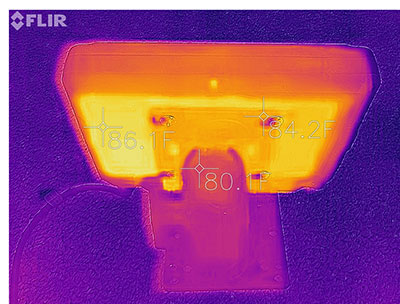 The backside has a large metal insert that provides a rock-solid base for VESA mounting screw holes and also serves as a heatsink and heat spreader. The insert is made of ADC-12 die-cast aluminum alloy that contains precisely proportioned amounts of silicon, copper, magnesium, iron, manganese and zinc, resulting in the desired material properties as well as suitability for intricate machining and environmental resistance. The material can withstand very high operating temperatures, offers good thermal conductivity, doesn't corrode, and provides excellent EMI and RFI shielding properties.
The backside has a large metal insert that provides a rock-solid base for VESA mounting screw holes and also serves as a heatsink and heat spreader. The insert is made of ADC-12 die-cast aluminum alloy that contains precisely proportioned amounts of silicon, copper, magnesium, iron, manganese and zinc, resulting in the desired material properties as well as suitability for intricate machining and environmental resistance. The material can withstand very high operating temperatures, offers good thermal conductivity, doesn't corrode, and provides excellent EMI and RFI shielding properties.
The image to the right shows the thermal footprint of the VIKING VIKING. The infrared picture, taken with our lab's FLIR ONE Pro thermal imaging camera, shows how cool our review unit stayed while operating, and how very effectively the metal heat exchanger with its large surface area spreads and dissipates the heat.
Internal expansion sits beneath that big, thick die-cast aluminum plate that's plenty strong enough to host the unit's VESA 75 x 75 screw mount pattern. It's secured with nine Philips head screws and includes a tongue-and-groove seal designed to keep dust and liquids out. The groove contains a replaceable white O-ring which must be in perfect condition, since any liquid that gets past this cover would go directly into the guts of the computer.
The images below show the backside of the VIKING with the die-cast aluminum plate removed. Note the thermal pads and blocks on the metal plate. RuggON adds those for heat transfer and dissipation from integrated electronics as well as optional modules.
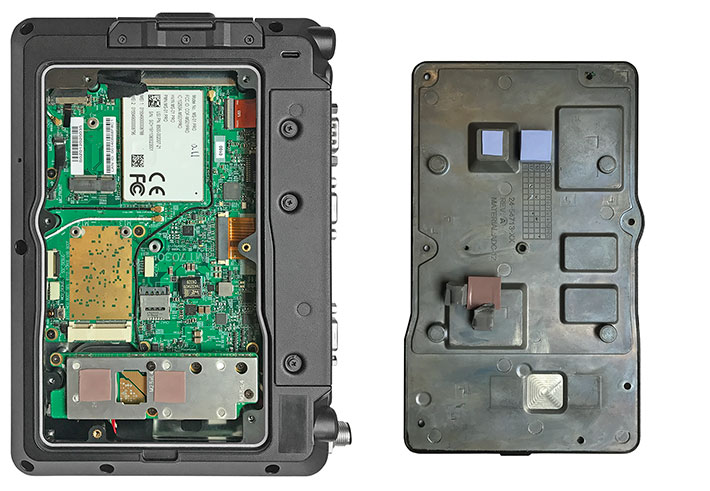
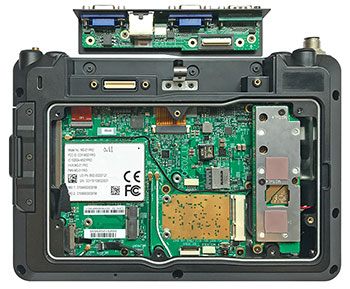 Here you find a mini PCIe card connector as well as a secondary Micro SIM card slot. There's also another small module slot that can be used for additional expansion. All of these slots have the prerequisite antenna wires already in place and waiting to be plugged in.
Here you find a mini PCIe card connector as well as a secondary Micro SIM card slot. There's also another small module slot that can be used for additional expansion. All of these slots have the prerequisite antenna wires already in place and waiting to be plugged in.
Note that all of these electronic modules receive passive cooling via the VIKING's large die-cast aluminum back plate that serves as a very efficient heat spreader and dissipator.
Continuing with the disassembly requires removal of just a few more Philips head screws and then careful unplugging of the flat ribbon cable that goes to the USB Type-C port, and also of a small microphone connector wire.
The front part of the device housing contains all electronics, the LCD display, digitizer and ancillary circuitry, all mounted on and protected by a strong steel or aluminum subframe. There are no additional expansion ports or configuration options here, so most customer may never have the need to separate the halves.
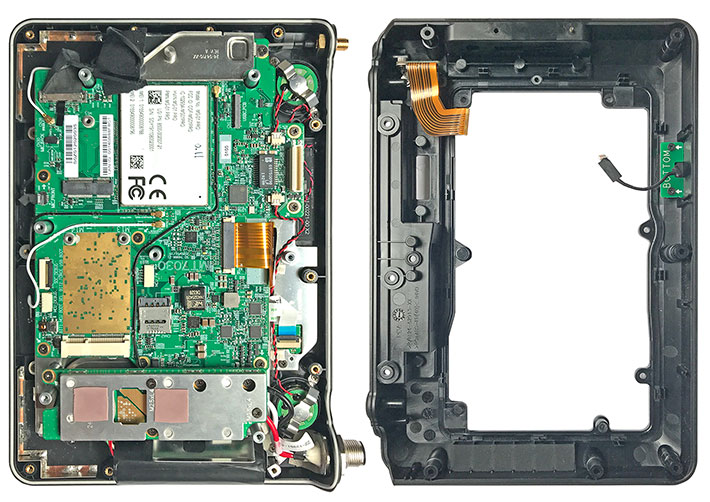
The roughly 5-1/2 x 4-1/4 inch rectangular motherboard looks more like an embedded Single Board Computer than the tiny hyper-miniaturized circuits found inside a modern smartphone or consumer tablet.
One reason why the Android-based RuggON VIKING needs far fewer individual modules than comparable Windows-based devices is that almost everything is integrated into the unit's MS-01 PRO System-On-Module, sourced from USI (Universal Scientific Industrial Co), that includes the Qualcomm Snapdragon SDM660 chip, the unit's eMMC LPDDR4 storage, 802.11a/b/g/n/ac Wi-Fi, Bluetooth 5.0, GNSS (Global Navigation Satellite System) with GPS/GLONASS/Beidou/Galileo support, mobile broadband, as well as the camera and display interfaces.
Unlike RuggON's larger VX-601 vehicle computer that also has a big externally accessible battery that acts as an uninterruptible power supply and also guards against unstable power during vehicle operation, the VIKING exclusively relies on external vehicle power. There is, however, a small 7 watt-hour bridge battery that can keep the system running for (we estimate) a good half hour or more while it's being transferred between vehicles.
The VIKING's I/O is split into a few edge-mounted ports (USB, audio, Micro SD Card, Mini SIM card) and the separate plug-in I/O module that in our unit included LAN, digital I/O, USB/serial combo, and DB9 serial.
Finally, below, some details. From left to right, the tongue-and-groove seal between the housing halves; one of the meticulously installed and secured speakers; and a look at some of the neatly arranged and preinstalled antenna wires leading from the modules to the actual antennae mounted along the inside perimeters of the device.

Display
A good display is crucial in any computer, and especially so in a vehicle mount system where operators may work in the dim lighting of a warehouse, on the road at night, in bright sunshine, and also in rapidly changing lighting conditions. That requires a display that can handle all those conditions, as well as all the physical abuse inherent to vehicle mounts.
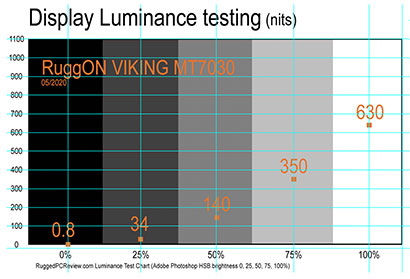 How did RuggON address the display issue? With an industrial-grade 7-inch 1024 x 600 pixel LCD, which makes for 170 pixels per inch. That's not terribly sharp when compared to consumer tablets or smartphones (the latter can reach well over 500 ppi), but it's plenty sharp enough for vehicle use.
How did RuggON address the display issue? With an industrial-grade 7-inch 1024 x 600 pixel LCD, which makes for 170 pixels per inch. That's not terribly sharp when compared to consumer tablets or smartphones (the latter can reach well over 500 ppi), but it's plenty sharp enough for vehicle use.
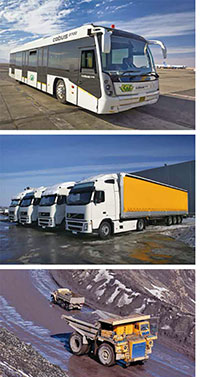 Vehicle displays must be bright enough to clearly and easily be seen. No need to be super-bright as VIKING units won't likely be used in direct broad sunlight, but bright enough to always easily convey information. For that, RuggON provides a stated luminance of 500 nits. We actually measured peak brightness to be 630 nits. Either way, 500-600 nits is about the same as you get from a modern smartphone or tablet — bright enough for almost all conditions.
Vehicle displays must be bright enough to clearly and easily be seen. No need to be super-bright as VIKING units won't likely be used in direct broad sunlight, but bright enough to always easily convey information. For that, RuggON provides a stated luminance of 500 nits. We actually measured peak brightness to be 630 nits. Either way, 500-600 nits is about the same as you get from a modern smartphone or tablet — bright enough for almost all conditions.
There is fairly responsive auto-dimming, and while the display is "glossy," reflections aren't generally an issue in vehicle-mounts.
We could not determine the LCD's origin and thus did not have access to its complete specs. Visual inspection shows a wide horizontal viewing angle without any contrast or color shifts when viewed from different angles. The vertical viewing angle is wide also, but it does show fairly significant contrast shifts.
This is less of an issue in fixed-mount vehicle computers than it would be in a laptop or tablet, because fixed-mount means the operator will look at the screen from the same angle every time. So as long as the panel is optimally mounted, such contrast shifts won't be an issue.
The VIKING has capacitive multi-touch, and all the tapping, dragging, pinching and zooming works as effortlessly as on any modern tablet or smartphone.
Operating system and overall functionality
RuggON is doing customers a huge favor by making their primary rugged tablet and vehicle-mount platforms available with either Windows or Android, each matched and optimized to the hardware. The VIKING comes with Android version 9, codenamed "Pie." As of May 2020, this is the most widely used version of Android with a global version share of about 34%. Note that RuggON supplies the full Android GMS (Google Mobile Services) version access to all Google apps, services, and the Google app store.
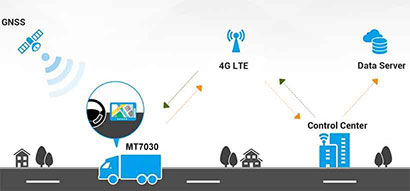 As far as possible applications go, the opportunities are endless. Equipped with WiFi, mobile broadband, and dedicated GNSS plus antennae, the VIKING is completely connected both in-vehicle and as part of IoT/cloud wide area applications. This enables a vast range of productivity enhancement and value-added functionality, and it also makes the VIKING perfect for any number of edge computing applications.
As far as possible applications go, the opportunities are endless. Equipped with WiFi, mobile broadband, and dedicated GNSS plus antennae, the VIKING is completely connected both in-vehicle and as part of IoT/cloud wide area applications. This enables a vast range of productivity enhancement and value-added functionality, and it also makes the VIKING perfect for any number of edge computing applications.
The illustration to the right outlines some of these scenarios. Vehicle, satellites, the cloud, and terrestrial control centers all working together to provide services, information, and functionality that simply weren't available and possible just a few years ago.
Now add to that IoT — the "Internet of Things" — and you have systems that are no longer limited to people or machines communicating with each other. In the IoT, "things" communicate as well. "Things" may be truck, their components, their freight, installed cameras, vehicle sensors — anything that can measure something and pass that data on for processing and feedback. The total market for all of this combined is gargantuan.
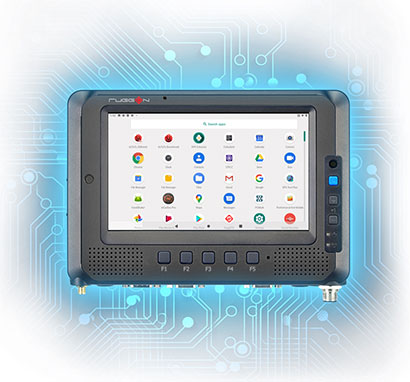 To make it all possible, the VIKING includes wired onboard connectivity that goes well past that available on standard tablets or laptops. Not just USB and LAN ports, but also legacy serial RS232 and selectable RS232/422/485, and then digital I/O, CAN Bus and (optional) SAE J1939.
To make it all possible, the VIKING includes wired onboard connectivity that goes well past that available on standard tablets or laptops. Not just USB and LAN ports, but also legacy serial RS232 and selectable RS232/422/485, and then digital I/O, CAN Bus and (optional) SAE J1939.
Though CAN Bus (Controller Area Network) has been around since the 1980s, its almost universal support makes it as robust, flexible, and efficient way of communicating with ECUs, sensors and actuators. SAE J1939 is a set of standards built on CAN and is used for diagnostics as well as specific sets of applications.
Among accessories RuggON offers for the VIKING is a RAM mounting kit that also provides access to the vast variety of RAM Mounts mobile mounting solutions, and a variety of wired external antennae for WiFi/Bluetooth as well as mobile broadband and GNSS. Our review unit came with an external GPS antenna puck with a low noise amplifier and a 17-foot RF cable. Proper placement of the puck can dramatically improve vehicle GNSS reception.
Overall, the RuggON VIKING VIKING is another example of how Android is coming into its own as a strong operating platform for rugged vehicle-mount devices.
Ruggedness
Ruggedness requirements for vehicle-mount computers are different from those for rugged tablets or laptops. Vehicle-mounts aren't carried around on the job, so drop resistance isn't as important. On the other hand, vehicle-mounted computers are exposed to far more vibration (inherent in vehicles) and shock (potholes, road conditions). And temperature resistance is also important because, depending on the mounting location, it can get very hot and very cold inside vehicles.

Available environmental specs of the RuggON VIKING are impressive. The device has a very wide operating temperature range of -4° to 140°F (-20° to 60°Centigrade) in accordance with MIL-STD-810H 501.7 High Temperature Procedure II and MIL-STD-810H 502.7 Low Temperature Procedure II. This means RuggON's tough compact vehicle-mount computer can be operated even in freezers and on any other assignments where it will encounter very low temperatures.
 In the past, rotating hard disks were one of the primary sources of failure in rugged computing systems due to temperature extremes as well as bumps and grinds that caused head crashes.
In the past, rotating hard disks were one of the primary sources of failure in rugged computing systems due to temperature extremes as well as bumps and grinds that caused head crashes.
Thanks to the decreasing cost of solid state storage media, Solid State Disks are the new standard in almost all rugged computing gear, including the VIKING. It's safe to say that its onboard eMMC storage is immune to shock and vibration.
Water and dust protection is at the IP65 equivalent, where the 6 stands for total protection against dust, and the 5 for protection against strong jets of water from all directions. This is better protection than one normally needs in an enclosed vehicle, but some VIKINGs may be mounted in more open vehicles, such as dozers, scrapers, cranes and such. In construction and similar open machines, the computer can be hosed down with the rest of the vehicle.
As far as resistance to vibration goes, RuggON refers to the MIL-STD-810H 514.8 procedures that describe vibration exposure testing for US highway trucks (Figure 514.8C-1 Category 4), composite two-wheeled trailers (Figure 514.8C-2 Category 4), and composite wheeled vehicles (Figure 514.8C-2 Category 4). RuggON also refers to IEC 60721-3-5 Class 5M3.

Since ruggedness testing results can be extensive, manufacturers usually only include highlights into their tech specs. RuggedPCReview.com recommends to always request all available ruggedness testing results, especially as they pertain to planned deployment of a device.
The RuggON VIKING vehicle mount: bottom line
With the VIKING, RuggON Corporation provides a small, compact, versatile, thoughtfully designed and manufactured ultra-rugged vehicle mount computer for use in a very wide variety of deployments that require a competent, reliable and fanless fixed-mount system. Small enough to be mounted almost anywhere, the nearly indestructible VIKING addresses the needs of customers who need an easy-to-use Android-based onboard computer with substantial wired and wireless connectivity that can also tie into vehicle networks.
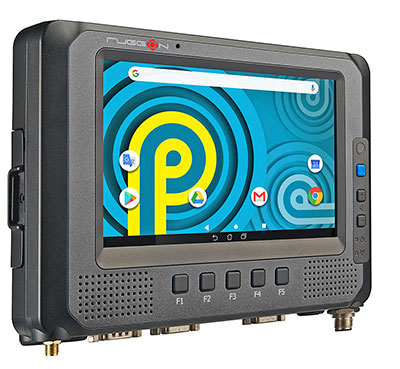 Designed for a wide variety of vehicle application needs, the VIKING provides an Android 9 alternative to RuggON's Window-based MT7000. The two versions share size, design, interface and most functionality, but each uses a processor and electronics optimized for its operating system platform.
Designed for a wide variety of vehicle application needs, the VIKING provides an Android 9 alternative to RuggON's Window-based MT7000. The two versions share size, design, interface and most functionality, but each uses a processor and electronics optimized for its operating system platform.
Offering both a capacitive multi-touch screen with the standard trio of Android software controls and five programmable hardware buttons makes the device safe and easy to use in vehicles. The highly integrated Snapdragon SD660 processor provides very good performance, the kind today's users have come to expect from their electronic devices.
The 7-inch 500 nits (we measured 630 nits) display is bright and offers sufficient resolution for any onboard tasks. The display offers decent reflection control and viewing angles. There's an optional user-facing camera.
The VIKING is an extremely rugged device whose IP65 sealing makes it impervious to dust and capable of being hosed off when dirty. It has a very wide operating temperature range (-4 to 140 degrees Fahrenheit), as well as the requisite vibration resistance for use in vehicles.
All this makes the VIKING VIKING a compelling example of a flexible, multi-purpose fleet management solution that merges sensor, communications, processing and advanced human interface technologies into a tough and rugged state-of-the-art Android device optimized for the needs of the transportation industry.
-- Conrad H. Blickenstorfer, May 2020
Specifications RuggON VIKING
| Added/changed |
Added 03/2020, full review 05/2020
|
| Type |
Rugged Vehicle Mount PC
|
| Processor |
Octa-core Qualcomm SD660
|
| Processor clock speed |
1.9 GHz
|
| Graphics |
Adreno 512
|
| OS |
Android 9.0 with Google Mobile Services
|
| RAM |
3GB LPDDR4 SDRAM
|
| Disk/drive |
32GB eMMC and microSD card
|
| Display type |
LED-backlit TFT with auto-dimming, 500 nits, wide viewing angle |
| Display size/resolution |
7.0 WSVGA (1024 x 600 pixels), 170 ppi |
| Digitizer |
10-point projective capacitive multi-touch
|
| Keyboard/keys |
5 programmable buttons
|
| Navigation |
Touch
|
| Expansion slots |
1 x microSD, 2 x micro SIM
|
| Housing |
PC + ABS plastics
|
| Size |
8.7 x 6.0 x 1.61 inches (220 x 152 x 41 mm)
|
| Weight |
2.75 lbs (1.25kg)
|
| Operating temperature |
-4° to 140°F (-20° to 60°C) in accordance with MIL-STD-810H
|
| Ingress protection |
IP65 (except bottom-side I/O) |
| Humidity |
Est: 5 to 95% non-condensing |
| Shock |
MIL-STD-810G 40G at 11ms terminal/sawtooth |
| Vibration |
MIL-STD-810H |
| Altitude |
MIL-STD-810H in applicable areas |
| Power |
9~36V VDC, 3.6V/1950mAh/7 watt-hour Li-Ion backup battery, ignition sense, remote power on |
| Camera |
optional user facing
|
| Sensors |
3-axis G-sensor, ambient light |
| Communication |
1 x RS232, 1 x RS232/422/485, 2 x USB 2.0, 1 x USB 3.1 Type C, 1 x RJ45 gigabit LAN, 4 x DI/O, 1 x CANBus (SAE J1939 support), headset jack
|
| Interface
|
1 x RS232, 1 x RS232/422/485, 2 x USB 2.0, 1 x USB 3.1 Type C, 1 x RJ45 gigabit LAN, 4 x DI/O, 1 x CANBus (SAE J1939 support), headset jack
|
| Price
|
Inquire |
| Spec sheet |
 RuggON VIKING brochure (PDF) RuggON VIKING brochure (PDF)
|
| Web page |
RuggON VIKING web page |
| Contact |
 RuggON Corporation
RuggON Corporation
4F., No. 298, Yang Guang St., NeiHu Dist.
Taipei City 11491, Taiwan
Telephone: 886-2-8797-1778
Fax: 886-2-8797-1881
Web: www.ruggon.com
info@ruggon.com
|
